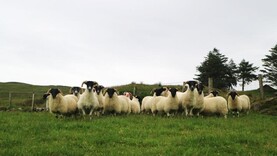OviFlock launch: The OviFlock European Innovation Project (EIP) was officially launched by Noel Grealish, Minister of State at the Department of Agriculture at Sheep 2025 on Saturday.
The five-year project aims to advance breeding in the hill sheep sector by identifying superior performing sheep and establishing flockbooks, while also reducing the risk of inbreeding.
Visits to hill ram breeding groups are under way. The objective in year one is to genotype approximately 8,000 ewes with flock visits coming on a first-come, first-served basis.
A facility to submit an expression of interest is now available on sheep.ie. For a flock to be considered eligible, they must be an active breeder of their respective ram breeding group.
Costs of genotyping these sheep will be covered by the project. Each participating breeder will be allocated a set number of free genotypes which can be used annually.
This will be influenced by factors such as flock size, number of breeding rams sold etc.
During flock visits, OviFlock technicians will collect valuable data such as ewe ID, ewe age, ewe weight, body condition score, teeth/mouth quality scores, lameness scores, cases of mastitis, etc.
Sheep Ireland highlights that a critical component of the project is for breeders to now identify the ewes of potential ram lambs, as these sheep are of most interest for genotyping.
Failing to do so will leave such animals impossible to identify at a later stage once weaning occurs.
Cobalt supplementation: Signs of cobalt deficiency generally do not start to emerge until July, but speaking with farmers at Sheep 2025 suggests that there are some early signs emerging.
Characteristic signs start with lambs performing below target, which is often hard to identify unless weighing regularly.
As such, the tell-tale symptom in many cases is lamb’s ears becoming scally or scabby, with skin flaking away.
Clinical symptoms of an acute deficiency include lambs going dry in the wool or starting to pine away despite being on a good plane of nutrition.
A loss of appetite will also be apparent, along with runny eyes and tear staining on the face and raised worm counts due to immunosuppression.
Lambs generally have a requirement for about 1mg of cobalt daily for vitamin B12 production, and as sheep do not have the ability to store cobalt they must acquire it on a regular basis via their diet or supplementation.
In a study undertaken in Teagasc Athenry, trace element supplementation with cobalt and a cobalt/B12/selenium mix increased average weight at drafting and carcase weight by 2.1kg and 1.4kg, respectively.
There was no significant benefit under the conditions in Athenry from including vitamin B12 and selenium.
Where administering an oral drench the best balance between labour input and preventing issues is to administer every two to three weeks.
Treatment will typically cover two weeks, but there will not usually be a major fall off in performance if the repeat treatment extends to three weeks.
If administering a bolus, then it is important to follow manufacturer’s guidelines and administer carefully as the lining of a lamb’s throat can be easily damaged through animals not being sufficiently restrained.
This can also occur when dosing lambs.
NSA sheep NI: The NSA Sheep NI 2025 event takes place on Tuesday 1 July in Dungiven, Co Derry (BT47 4QP).






 This is a subscriber-only article
This is a subscriber-only article










SHARING OPTIONS: